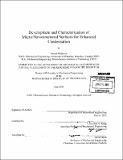| dc.description.abstract | Micro/nanostructures have long been recognized to have potential for heat transfer enhancement in phase-change processes by achieving extreme wetting properties, which is of great importance in a wide range of applications including thermal management, building environment control, water harvesting, desalination, and industrial power generation. This thesis focuses on the fundamental understanding of water vapor condensation on superhydrophobic surfaces, as well as the demonstration of such surfaces for enhanced condensation heat transfer performance. We first studied droplet-surface interactions during condensation on superhydrophobic surfaces to understand the emergent droplet wetting morphology. We demonstrated the importance of considering local energy barriers to understand the condensed droplet morphologies and showed nucleation-mediated droplet-droplet interactions can overcome these barriers to develop wetting states not predicted by global thermodynamic analysis. To minimize these droplet-droplet interactions and ensure the formation of favorable morphologies for enhanced condensation heat transfer, we show that the structure length scale needs to be minimized while ensuring the local energy barriers satisfy the morphology dependent criteria. This mechanistic understanding offers insight into the role of surface-structure length scale and provides a quantitative basis for designing surfaces optimized for condensation in engineered systems. Using our understanding of emergent droplet wetting morphology, we experimentally and numerically investigated the morphology dependent individual droplet growth rates. By taking advantage of well-controlled functionalized silicon nanopillars, the growth and shedding behavior of both suspended and partially wetting droplets on the same surface during condensation was observed. Environmental scanning electron microscopy was used to demonstrate that initial droplet growth rates of partially wetting droplets were 6 times larger than that of suspended droplets. A droplet growth model was developed to explain the experimental results and showed that partially wetting droplets had 4-6 times higher heat transfer rates than that of suspended droplets. Based on these findings, the overall performance enhancement created by surface nanostructuring was examined in comparison to a flat hydrophobic surface. These nanostructured surfaces had 56% heat flux enhancement for partially wetting droplet morphologies, and 71% heat flux degradation for suspended morphologies in comparison to flat hydrophobic surfaces. This study provides fundamental insights into the previously unidentified role of droplet wetting morphology on growth rate, as well as the need to design nanostructured surfaces with tailored droplet morphologies to achieve enhanced heat and mass transfer during dropwise condensation. To create a unified model for condensation capable of predicting the surface heat transfer for a variety of surface length scales, geometries, and condensation conditions, we incorporated the emergent droplet wetting morphology, individual droplet heat transfer, and size distribution. The model results showed a specific range of characteristic length scales (0.5 - 2 ptm) allowing for the formation of coalescence-induced jumping droplets with a 190% overall surface heat flux enhancement over conventional flat dropwise condensing surfaces. This work provided a unified model for dropwise condensation on micro/nanostructured superhydrophobic surfaces and offered guidelines for the selection of ideal structured surfaces to maximize heat transfer. Using the insights gained from the developed model and optimization, a scalable synthesis technique was developed to produce functionalized oxide nanostructures on copper surfaces capable of sustaining superhydrophobic condensation. Nanostructured copper oxide (CuO) films were formed via chemical oxidation in an alkaline solution resulting in dense arrays of sharp CuO nanostructures with characteristic heights and widths of -1 pm and -300 nm, respectively. Condensation on these surfaces was characterized using optical microscopy and environmental scanning electron microscopy to quantify the distribution of nucleation sites and elucidate the growth behavior of individual droplets with characteristic radii of -1 to 10 pm at supersaturations < 1.5. Comparison of the measured individual droplet growth behavior showed good agreement with our developed heat transfer model. We subsequently studied the macroscopic heat transfer performance during water condensation on superhydrophobic CuO tube surfaces in a custom built experimental chamber. The results experimentally demonstrated for the first time a 25% higher overall heat flux and 30% higher condensation heat transfer coefficient compared to state-of-the-art hydrophobic condensing surfaces at low supersaturations (<1.12). This work not only shows significant condensation heat transfer enhancement, but promises a low cost and scalable approach to increase efficiency for applications such as atmospheric water harvesting and dehumidification. Furthermore, the results offer insights and an avenue to achieve high flux superhydrophobic condensation. In addition to demonstrating enhanced heat transfer performance, we discovered electrostatic charging of jumping droplets on CuO. With the aid of electric fields, the charge on the droplets was quantified, and the mechanism for the charge accumulation was studied. We demonstrated that droplet charging was associated with the formation of the electric double layer at the droplet-surface interface, and subsequent separation during coalescence and jumping. The observation of droplet charge accumulation and electric double layer charge separation provides important insight into jumping droplet physics. Furthermore, this work is a starting point for more advanced approaches for enhancing jumping droplet surface performance by using external electric fields to control droplet jumping. Finally, we demonstrated electric-field-enhanced (EFE) condensation, whereby an external electric field was used to force charged departing droplets away from the surface and limit their return. With the CuO surfaces, we studied EFE condensation heat transfer performance during water condensation. The results experimentally demonstrated a 50% higher overall heat transfer coefficient compared to the no-field jumping surface at low supersaturations (<1.12). This work not only shows significant condensation heat transfer enhancement, it offers insights into new avenues for improving the performance of self-cleaning and anti-icing surfaces, as well as thermal diodes. This thesis presents improved fundamental understanding of wetting and condensation on micro/nanostructures as well as practical implementation of these structures for enhanced condensation heat transfer. The insights gained demonstrate the potential of new surface engineering approaches to improve the performance of various thermal management and energy production applications. | en_US |
